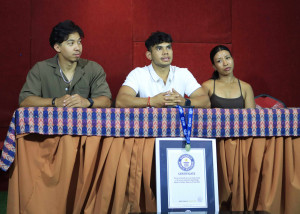Sports
Nepali fencers look to transform the sword game
Fencing, one of the five sports featuring regularly since modern Olympic Games in 1896, is making its debut at the South Asian Games.
Prarambha Dahal
Nepali fencers will be looking to put behind adversities facing them and set the tone for bringing this game of swordsmanship to the mainstream in the country when it makes a debut at the South Asian Games.
Fencing is one of the five sports that has been part of the first modern Olympic Games since their inception in 1896. Athletics, swimming, cycling and gymnastics are the others. Modern fencing includes three disciplines foil, epee and sabre where points are won through the sword's contact with an opponent.
A team of 24 Nepali fencers—12 men and women each—are currently undergoing a closed session training in preparation for the regional mega sporting event that Nepal is hosting from December 1-10. Nepal will be joined in by India, Sri Lanka, Bangladesh and Pakistan as they vie for 36 medals, including 12 gold—six each in the men's and women's individual and team events.
Abhishek Karki, former fencer and head coach of Nepali fencing team, describes the sport as the amalgam of physical agility and mental sharpness.
"Fencing, despite being played with a sword wearing the white kit and safety gears, is similar to chess, it is very strategic and requires immense concentration from a fencer to earn points," he says.
Nepali fencers made their international debut at the first South Asian Fencing Championship in Chennai, India in 2010 where they won 12 bronze medals.
Two years later, Nepal returned from the second edition in Hyderabad with as many bronze medals. But Nepal has not contested at the South Asian Championship for the past seven years.
Last year, Nepali fencers participated in the Asian Championship in Bangkok where Nepali fencers won against their rivals from Bangladesh and Sri Lanka but fell short against Indian opposition.
“India are really good at the sport, but we are still aiming for gold at the Games. We have been training really hard and putting in a lot of effort," Karki says.
But the training at the Nepali camp is not going as smooth as the players and coaches would have liked.
Lack of authentic gears for fencers during the training session has been a major concern. "The gears of this sport are quite expensive and not available in Nepal,” he says. “We have been training with substandard swords which are heavier and less flexible compared to the ones used in the Games.”
The authentic gears cost more than Rs125,000 but the team has been using Chinese gears that are available at around Rs25,000.
The competitions during the Games will be held using the swords as specified by the Federation Internationale d'Escrime, the sport's international governing body.
Karki has apprehensions that the lack of proper swords for practice sessions could affect their medal chances.
"The National Sports Council has promised us better gears for our preparations, but the delay in procurement is not doing us any good," Karki says.
Fencer Omkar Singh has been participating in national and international fencing tournaments since 2011.
"Fencing is yet to grow in Nepal as there are not many motivating factors to entice people to follow this sport at present. Most of the fencers have other jobs to support their livelihoods,” says Singh who will be competing in epee.
But Singh believes one exemplary performance by a Nepali fencer at these Games could transform the face of the game and help it grow from its current embryonic stage. “That will see more people taking to fencing."
Singh has always been fascinated by a unique aspect of fencing. “After the bullets in shooting, the tip of the sword in fencing is the fastest moving object in any Olympic sport," he says.
Sikshya Napit, who went to watch a demonstration show on fencing one day at Sherpa Mall, returned enamoured of the sport.
"Despite being a combat sport, fencing is safe. The psychological aspect of the game is the most compelling factor," says the 14-year-old. She will be competing in a sabre event.
Napit, who stands at five feet one inch, says, "Height is a major factor in fencing. As I am relatively shorter, I have to make a few adjustments like taking more steps while competing with a taller opponent."
Nepali fencers are set to participate in the Chulalongkorn University Open Tournament taking place in Bangkok from November 1-3 to gain match exposure. The team plans to hire two foreign coaches upon their return to Kathmandu on November 20 and start a 15-day training camp in the run-up to the Games.
When asked about their possible strategies to get the better of their opponents, Singh answered, "You cannot always play to a set plan in fencing. Correct timing, precision, and reading the mind of your rivals and their movements are key to winning points.
“Irrespective of your plan in mind, the opponent can make different moves on the spur of the moment. We’ve got to be ready for anything. The key is to remain calm," Singh adds.
With a lot riding on their performance in popularising the sport in the country, the Nepali fencers don’t want to leave anything to chance in that pursuit.
Rabina Thapa, who took up fencing only four years ago, says, "The sport is very fascinating which requires the player to be very strategic. The contest itself may last roughly 10 minutes, but there’s a lot more to it."
The lack of proper training equipment, infrastructure has been a stumbling block, Thapa explains the problems facing fencers in the country. “A lot remains to be done in fencing in Nepal,” she says.
“The sports authorities should recognise fencing as a potential sport for winning medals at the international level, and as players, we must deliver as well.”




 21.45°C Kathmandu
21.45°C Kathmandu

















